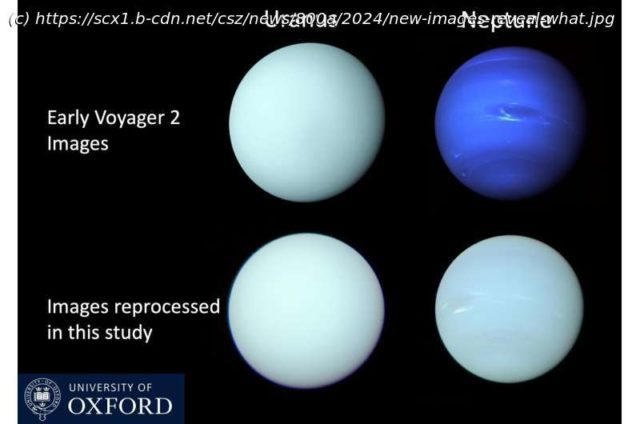Neptune is fondly known for being a rich blue, and Uranus green—but a new study has revealed that the two ice giants are actually far closer in color than typically thought.
Neptune is fondly known for being a rich blue, and Uranus green—but a new study has revealed that the two ice giants are actually far closer in color than typically thought.
The correct shades of the planets have been confirmed with the help of research led by Professor Patrick Irwin from the University of Oxford, which has been published today in the Monthly Notices of the Royal Astronomical Society.
He and his team found that both worlds are in fact a similar shade of greenish blue, despite the commonly-held belief that Neptune is a deep azure and Uranus has a pale cyan appearance.
Astronomers have long known that most modern images of the two planets do not accurately reflect their true colors. The misconception arose because images captured of both planets during the 20th century—including by NASA’s Voyager 2 mission, the only spacecraft to fly past these worlds—recorded images in separate colors.
The single-color images were later recombined to create composite color images, which were not always accurately balanced to achieve a „true“ color image, and—particularly in the case of Neptune—were often made „too blue.“
In addition, the early Neptune images from Voyager 2 were strongly contrast enhanced to better reveal the clouds, bands, and winds that shape our modern perspective of Neptune.
Professor Irwin said, „Although the familiar Voyager 2 images of Uranus were published in a form closer to ‚true‘ color, those of Neptune were, in fact, stretched and enhanced, and therefore made artificially too blue. Even though the artificially-saturated color was known at the time among planetary scientists—and the images were released with captions explaining it—that distinction had become lost over time. Applying our model to the original data, we have been able to reconstitute the most accurate representation yet of the color of both Neptune and Uranus.“
In the new study, the researchers used data from Hubble Space Telescope’s Space Telescope Imaging Spectrograph (STIS) and the Multi Unit Spectroscopic Explorer (MUSE) on the European Southern Observatory’s Very Large Telescope.






